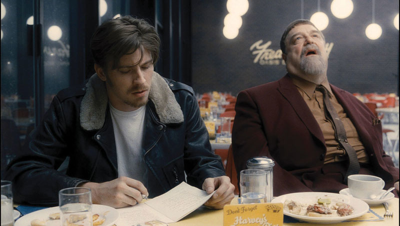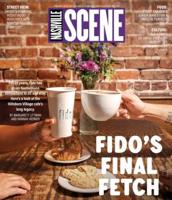It's impossible to conceive of modern American cinema without Joel and Ethan Coen. Prankster-poets of the highest degree, for 30 years they've been pillaging genres and serving up tales of morality and monstrousness with an increasingly expressive canvas. Following up their 2010 critical and commercial triumph True Grit, they now dive headlong into the early-'60s milieu of the Greenwich Village folk scene with the enigmatic and incisive Inside Llewyn Davis, with only an errant cat and 20 or so classic songs to lead the way. The Scene spoke with the Coens, co-star John Goodman and star Oscar Isaac at the press conference for Llewyn Davis at the 2013 New York Film Festival.
How early in the writing and development process did you start thinking of specific songs for the film?
EC: [Music supervisor] T Bone [Burnett] was the first person we sent the script to when we were finished with it. The conversation basically started at the moment we finished the script and knew we were going to do the movie.
JC: We were specifically thinking about Dave Van Ronk when we were thinking about the script and writing the script, so a lot of the songs were songs that he sang, or was associated with, or that he recorded; so some of the songs were there from the beginning.
OI: "Green Rocky Road," the one I play in the car — that was one. The big question for me, because it wasn't in the script, was which song I would play for F. Murray Abraham's character. There was a period of time when we weren't sure what it was, so there was a lot of going through songs, so there was a surprise when that one ended up being the one.
Mr. Goodman, "People Like Us" from David Byrne's True Stories is a classic, but you didn't sing in this film ...
JG: I did internally. My interior monologue was scored.
Is failure more interesting to make a movie about than success?
JC: The success movies have been done, haven't they? It's less interesting from a story point of view. ...
There's a sense that this is a grand epic on an emotional scale, but one that remains mostly internal. That would certainly give the cat more cosmic heft. And perhaps that makes [Goodman's character] Roland a siren?
JG: (Deadpan) I thought that was understood. ... All must work harder.
EC: John's past couple of films with us have had sort of a Homeric thing going on. ... We kind of thought of it as an Odyssey in which the main character doesn't go anywhere.
The emergence of Bob Dylan was a watershed moment that changed folk music forever, so it's intriguing how this film focuses specifically on the moment before. Was there a reason why you decided to explore that particular time and place in folk culture?
JC: The cultural moment that you were speaking of was very much on our mind as we were writing the story. We wanted to do something that was set in the scene before Dylan showed up; he came onto the scene and changed it and transformed it, and people know more about that. It seemed less interesting to us. ... There was a certain question of "authenticity" in the performing of traditional songs that the people involved with this early folk revival were very concerned with, and that had both interesting and ironic — that was also something that was interesting to us.
OI: In a way, these folk musicians were like curators, or DJs, who collected songs and would then present them. But once these songs were recorded, people would react — they had these recordings, so they wanted to hear new things. And that became a new movement. And then Dylan came around and synthesized what the Beat poets were doing with traditional music, and people got really jazzed about that.
There's a very specific, grey look to the film ...
OI: It was actually a very warm winter, and we were running around trying to get all these shots ...
EC: Spring came really early when we shot it, so we were fighting the oncoming green to maintain some of the bleakness. Actually, some of the shots use supplied snow; if you look closely, you can see blooming trees where there shouldn't be. But when you think about New York in the winter, you don't want to see green. It's the cover of The Freewheelin' Bob Dylan, that's that look, and the weather is part of that.
There was some talk early in the development of this film that it would be shot on 16mm black-and-white film; how long was that in consideration?
JC: It's very difficult to make black-and-white movies nowadays. ... Just from a wider stylistic point of view, we were sitting around with [director of photography] Bruno Delbonnel and trying to figure out how to shoot this film, and we started with that idea, but then as we started to break the script down into specific shots, we realized that so much of what we wanted to do just didn't lend itself to that. There's a residual bit of that left in some of the coverage in the club, the coffeehouse. The first shot in the movie starts out handheld ... But we started thinking how we wanted to follow this cat down a hallway, and you can't really do that with that handheld, Maysles aesthetic.
Is this going to be the last movie you shoot on film?
JC: It's possible. I have to say, I'm not wildly enthusiastic about the idea. This movie was shot on film for a number of reasons. We were making it with a cinematographer with whom we'd only made one short thing in the past, and Bruno also had never shot anything on digital before — he'd shot everything on film. And we thought that might be a complicating factor. I'm glad we shot it on film, but it's really a hybrid thing these days anyway. You shoot it on film but it all goes into a box; it all goes into a computer and gets heavily manipulated ... then edited on the DI and projected as DCPs. It's probable that the next one will be shot digitally.
Inside Llewyn Davis opens Friday, Dec. 20. After the 7:10 p.m. show opening night at The Belcourt, Grammy winner Janis Ian and Rhino Books proprietor and songwriter Fred Koller will discuss the '60s folk scene with musician Pete Finney.
Email arts@nashvillescene.com.





